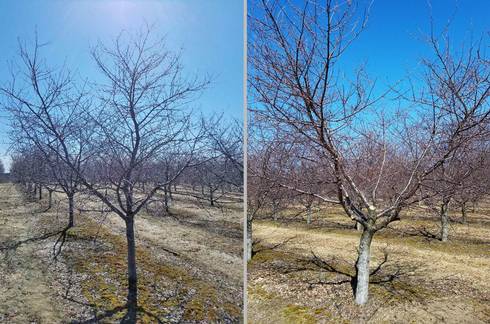Oct 3, 2018Cultural management strategies to reduce orchard suitability for SWD
Manipulation of the tart cherry orchard environment to reduce suitability for spotted wing Drosophila (SWD) has been suggested as a promising new component to SWD management systems. The team at the Northwest Michigan Horticulture Research Center successfully demonstrated that both annual pruning and bi-weekly mowing strategies reduced SWD infestation in no-spray trial blocks in 2017. These findings provide a foundation to further explore cultural management methods that could develop into an additional and reliable strategy for SWD control that could be employed by commercial growers.
However, prior to 2018 these cultural strategies had not been evaluated on commercial farms in combination with grower-standard insecticide programs. Furthermore, the 2017 trials evaluated treatments that were either mowed or not mowed at all, and these mowing strategies differ from conventional commercial mowing practices.
All commercial tart cherry growers mow at least two times per season. Research by Nikki Rothwell, Michigan State University Extension, showed a difference between never mowing and mowing every two weeks, but these differences may not be evident in a comparison of two mows per season compared with four to five mows per season. Growers are also universally applying insecticides every seven to 10 days in the three to four weeks prior to harvest to manage SWD, and the 2017 trials were conducted without insecticides.
The economic impact of adopting these cultural modification changes to the traditional tart cherry system may be significant. Tart cherry growers traditionally prune established trees only every two to three years, and they remove four to six larger limbs and clean up brush inside of the canopy. The standard mowing practice is to mow one time within a few days of Memorial Day weekend, and then to mow once more about a week before harvest to provide easier passage for mechanical harvesters. These strategies are low in cost and have been effective for traditional growers for decades. These low cost strategies are critical to grower returns, particularly at a time when tart cherry market prices are historically low.
Increasing the number of times a grower mows to a bi-weekly program can add two to three trips through the orchard, meaning additional time and cost to the production system. Pruning tart cherry trees on an annual basis also adds significant labor and costs to the system. Given the substantial added costs of either or both of these practices, clear data in commercial settings demonstrating significant SWD management benefit from the adoption of these changes is needed in order to provide clear recommendations on cultural and pest management practices to the tart cherry industry.
Four commercial tart cherry orchards in west central Michigan worked with MSU Extension on this trial. We established the following four treatments of 150 tart cherry trees per treatment for a total of at least 600 trees per site:
- Winter pruned with the standard mowing regimen (mowed over Memorial Day weekend and within a week of harvest).
- Winter pruned with a bi-weekly mowing regimen.
- No winter pruning with a standard mowing regimen.
- No winter pruning with a bi-weekly mowing regimen.
Three standard SWD cup traps were placed in the center of each treatment spaced at least 25 feet apart for a total of 12 traps per location. Traps were counted weekly from May 15 through harvest. Growers applied a standard SWD management program starting when fruit turned yellow or straw-colored. Growers applied two to three sprays from either the pyrethroid or organophosphate insecticide classes every seven to 10 days. All products applied are currently labelled “excellent” for SWD management.
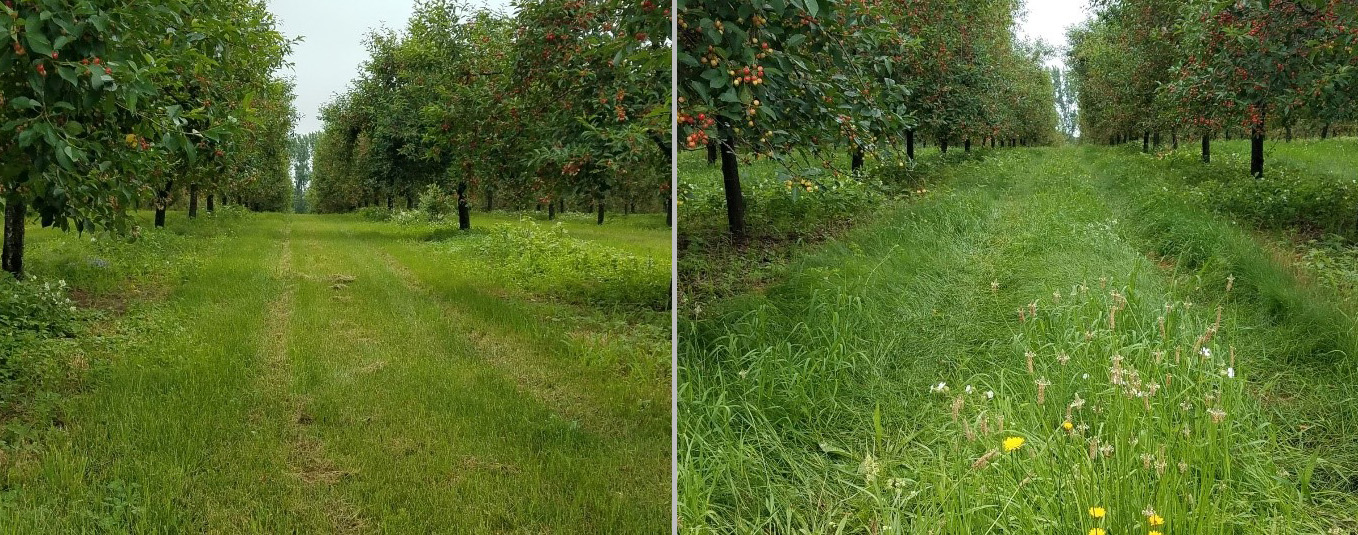

Past research has shown SWD has a preference for higher humidity. Based on this information, researchers investigated whether more humid areas in the tart cherry tree canopy (i.e., interior or bottom of the canopy) were more attractive to SWD than the less humid areas (i.e., top or outside of the tree).
Fruit samples were collected one week before harvest and at harvest; fruit were collected from the bottom of the tree, the top outside of the tree and the top middle of the tree. Three gallons of fruit were taken from each of these three locations in each of the four treatments on the two sample dates. Fruit were soaked in a standard sugar water solution for 15 minutes, strained through fine mesh and inspected for SWD larvae under a dissecting microscope.
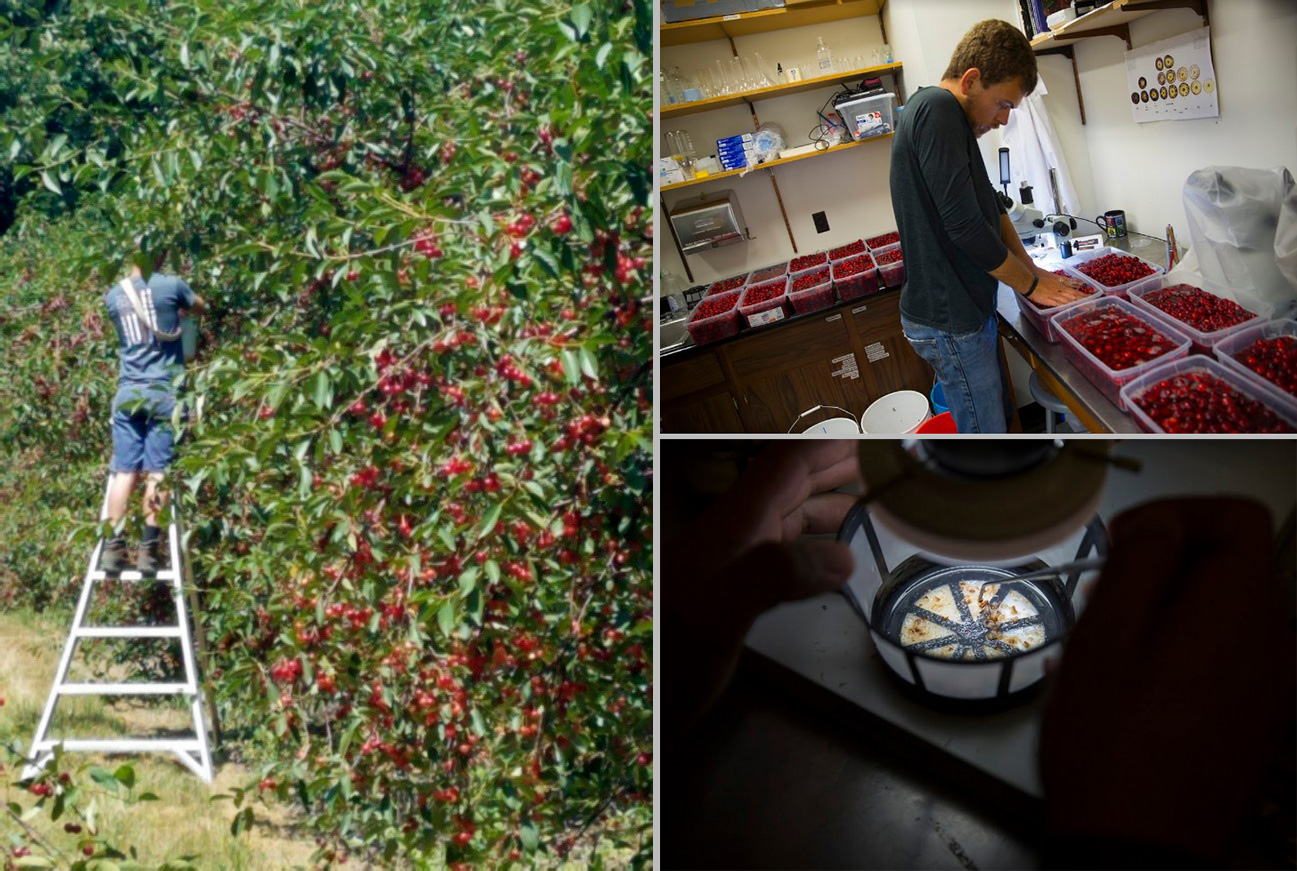

Results
Trap catch results
No significant differences in weekly trap catch through harvest was observed at any of the four sites between any of the four treatments in 2018 (ANOVA, p>0.05). In general, trap catches were abnormally low across the west central region in 2018 compared to 2017, and this trend was observable in the trapping numbers over the course of this study (Figures 1-5). SWD were observed in traps four to six weeks later in 2018 than in 2017, and population numbers never climbed to the levels observed in 2017 (Figures 1-5). Although differences were detected at the Northwest Michigan Horticulture and Research Center in 2017 in a no-spray situation between no mow versus two-week mow treatments and prune versus no prune treatments, these differences were not observed in 2018 in commercial sites.
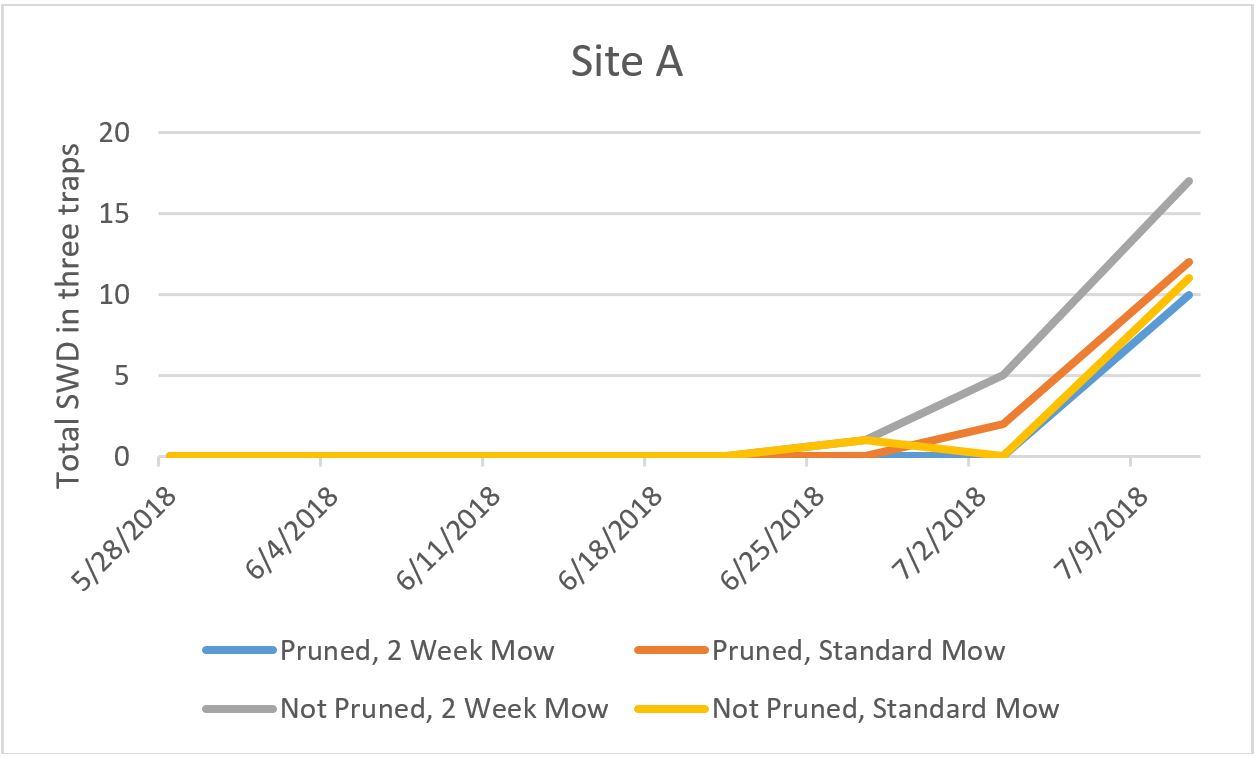

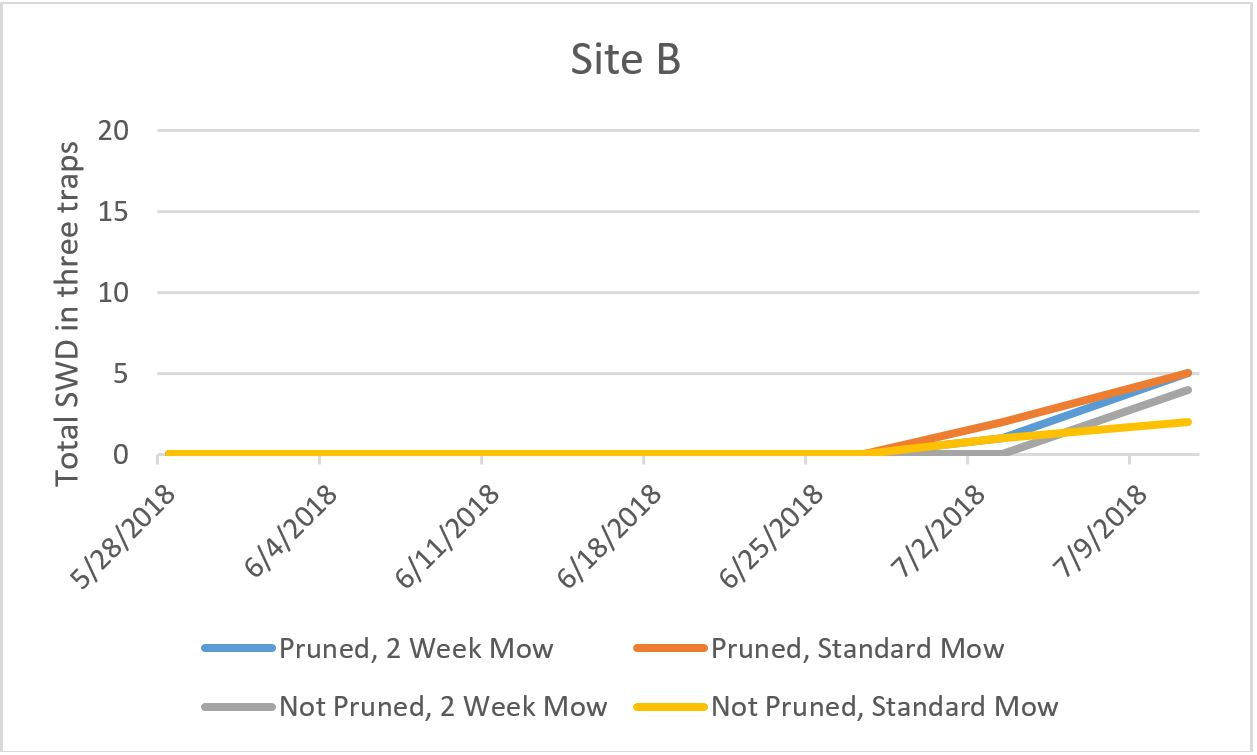

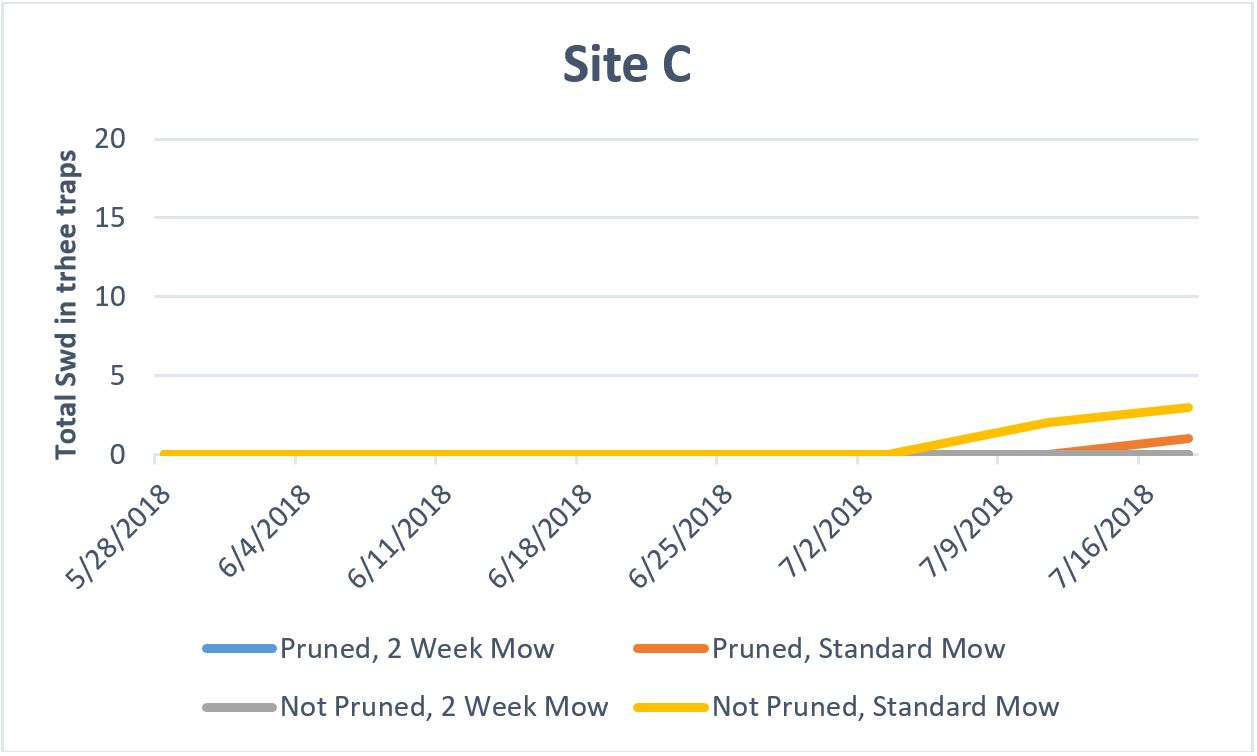

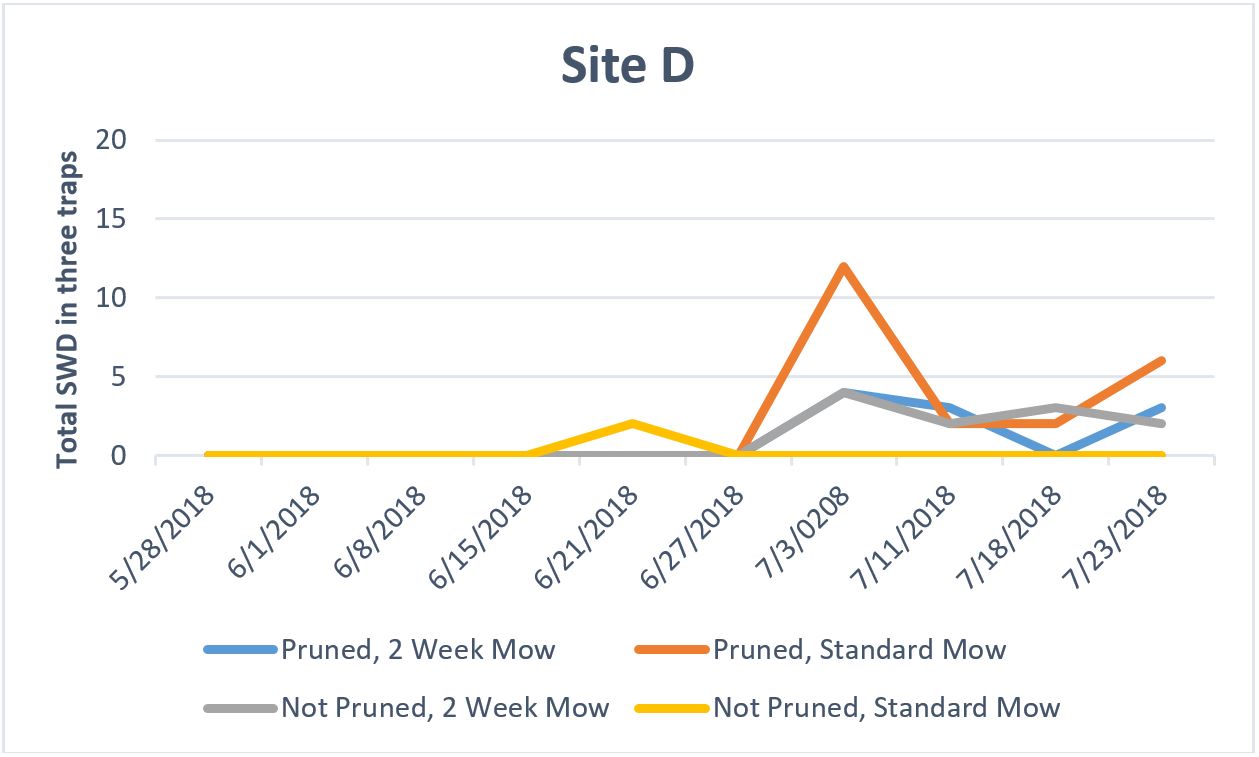

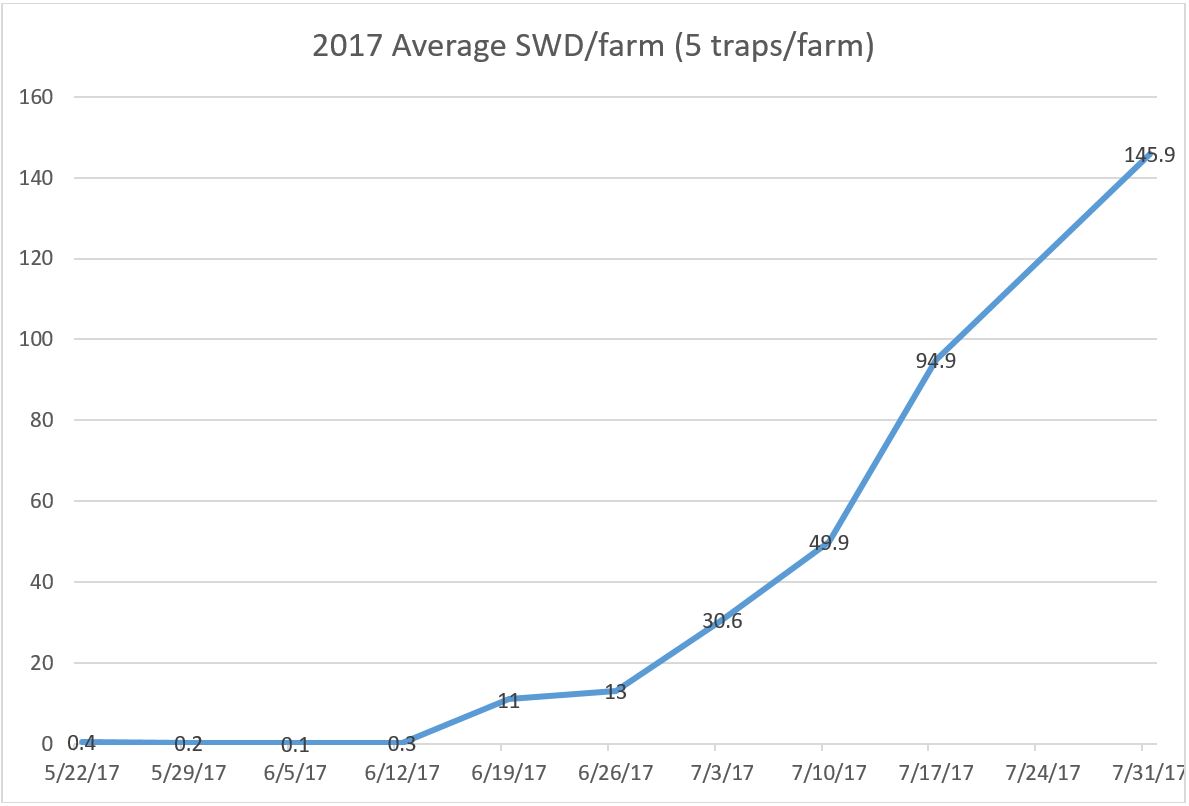

Fruit sampling
No SWD larvae were detected in any samples of any treatment from any of the positions on the tree. Growers at all four sites successfully harvested the crop without any detectable larval contamination. Samples collected one or more weeks post-harvest may have had differences in numbers of larvae, but sampling was not possible in this commercial orchard research because few (if any) cherries remained on the trees after harvest.
Impact of weather in 2018
In general, we saw far fewer SWD in 2018 compared with past seasons, both throughout the region and the state. We hypothesize that fewer SWD may be due at least in part to environmental factors. The spring of 2018 was abnormally late, and west central Michigan had several late snowfalls and freezes after brief warming periods in to late April. Following this long winter with variable temperatures, weather conditions were drier and hotter than the five-year average for the region from July through the first half of August.
These trends are in sharp contrast to 2017, which was a historically challenging year for SWD in the industry throughout the state. The summer of 2017 was more moderate in temperature, had an earlier spring and saw higher rainfall. The west central region accumulated 1,273 growing degree-days (GDD) base 50 in 2017 between April 30 and Aug. 1 compared to 1,560 GDD base 50 in 2018. In that same time span for both seasons, there was 13.94 inches and 223 hours of rainfall in 2017 compared to only 9.05 inches and 176 hours with rainfall in 2018. Three of the 10 commercial sites evaluated in 2017 were infested prior to harvest, while no infestation was detected in 2018.
We hypothesize that weather conditions that are more favorable for this pest would have shown differences between the different management practices. These results demonstrate the need for further data on these practices.
Impact of insecticides in 2018 trials
Differences in infestation in 2017 at the Northwest Michigan Horticulture and Research Center were observed in no-spray conditions. It is probable that the application of a commercial insecticide program mitigated differences that might have been observable in a no-spray scenario, particularly in a low-population year like 2018. However, higher SWD populations may have resulted in differences between cultural management treatments, even with commercial insecticide programs.
Conversely, it is possible differences in population or infestation risk that may be observed in cultural management trials under no-spray settings are generally wiped out in commercial settings by a high caliber insecticide program. Replication of this work in commercial settings is needed to gather more information on this subject.
Discussion
One year of data in commercial settings, particularly in a year with historically low SWD populations, is not adequate to make recommendations to commercial tart cherry producers. The weather likely contributed to the overall low SWD populations, and with no larval infestation in any of the treatments, we cannot draw any conclusions. Further replicating this trial in a year with higher SWD populations, such as 2017, may determine if bi-weekly mowing, annual pruning or both practices will impact SWD infestation.
Based on work at the Northwest Michigan Horticulture and Research Center, we can conclude that these cultural practices do impact SWD infestation, but we do not have data from commercial orchards to determine if adoption of these practices merits additional costs every season. More data are needed for recommendations in commercial tart cherry orchards.
– David Jones , Nikki Rothwell, Michigan State University
Photo at top: Unpruned treatment, left, and pruned treatment, right, in early spring 2018.


